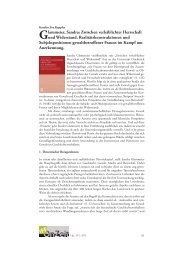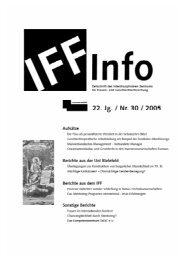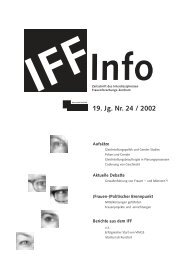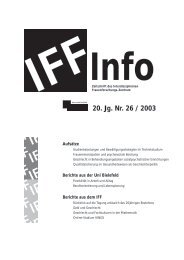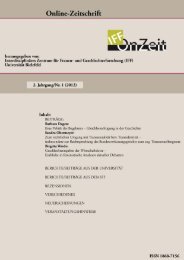IFFOnZeit Nr.1, 2009
IFFOnZeit Nr.1, 2009
IFFOnZeit Nr.1, 2009
Sie wollen auch ein ePaper? Erhöhen Sie die Reichweite Ihrer Titel.
YUMPU macht aus Druck-PDFs automatisch weboptimierte ePaper, die Google liebt.
Rezensionen<br />
Two articles focus on the relation between general organisational changes in<br />
universities and changes in gender equality policies. Mary Ann Danowitz Sagaria (Vienna<br />
University of Economics and Business Administration, Austria/University of Denver,<br />
USA) compares in her paper “Gender Equality as Organizational Change. Frames,<br />
Challenges, and Strategies in the European Union and the United States” various gender<br />
equality policies in US and EU countries. First of all she provides a brief overview of<br />
the differing conceptions of equality in the EU and US and shows: Universities on both<br />
sides of the North Atlantic share very similar patterns of gender representation among<br />
academic staff with neo-liberalism reshaping the purposes and workings of their institutions.<br />
However, the EU and the US differ significantly in their underlying principles of<br />
gender equality and policy contexts. In the EU countries the orientation have been more<br />
and more on gender mainstreaming, while in the US, gender equality is rather linked<br />
to diversity. Based on the author’s analysis of various case studies from EU und US, she<br />
presents five influential factors to explain changes in gender equality as a part of organization<br />
innovation and provides detailed examples of them. The highlighted factors are:<br />
the external environment, positive action from university leaders, supportive structures<br />
and incentives, funding measures, and auditing. The author concludes, that these five<br />
factors collectively explain the success and failure of institutional efforts towards gender<br />
equality progress. Jane Wilkinson (School of Education, Charles Sturt University, Wagga<br />
Wagga, Australia), explores in her paper “Keeping your Eye on the Prize: Gender Equality<br />
Programs in Enterprise Universities” the relationship between more general changes in<br />
Australian university management and their implications for gender equality programmes<br />
in Australian higher education. In Australia an enterprise model of management for Australian<br />
university leadership has opened up new possibilities for some women academics<br />
while simultaneously reasserting old gender hierarchies. The author examines the material<br />
impact of such changes through a series of interviews with senior women leaders from a<br />
diversity of class and ethnic origins, located in a variety of Australian universities. One<br />
important finding of her study is: A key strategy in both the implementation and evaluation<br />
of the ongoing effectiveness of gender equality programmes, is a greater understanding<br />
of the significant ways in which differences between groups of women based upon<br />
their ethnic and class origins are played out in a variety of institutional contexts in higher<br />
education. At the end of her paper the author points out potential policy implications of<br />
ethically and socioeconomically diverse academic women leaders which could be fruitful<br />
for similar institutions.<br />
Since the 1990s many countries and universities have adapted their gender equality<br />
policies or programmes to gender mainstreaming policies or programmes. Two articles<br />
of the anthology give a critical view on the impacts of this change and reflect factors contributing<br />
to the success or failure of gender mainstreaming measures. In her paper “Political<br />
Will is Not Enough: Results from the Evaluation of a Pilot Scheme for Implementing<br />
Gender Mainstreaming” Angelika Paseka (College of Teacher Education, Vienna, Austria)<br />
reported on a gender-mainstreaming project scheme (2001-2003) conducted at all<br />
Austrian teacher training colleges. This project was ordered by the Federal Ministry of<br />
Education, and involved 25 colleges. First of all the author describes the conditions and<br />
assumptions under which the pilot scheme took place. After this she presents selected results<br />
from the documentation of the implementation process of gender mainstreaming in<br />
this selected target group, gives a critical analysis about the organisations and their structure<br />
as a framework for this implementation process, and finally summarizes important<br />
1. Jg., Nr. 1, <strong>2009</strong><br />
150



